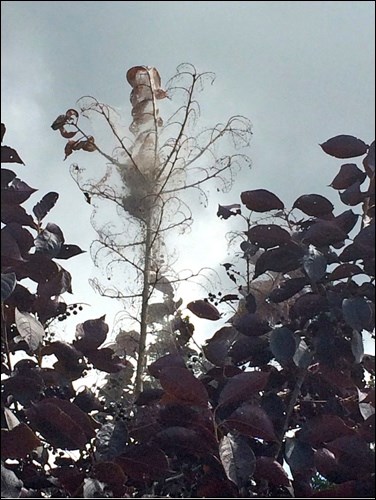You may have noticed some webbing on tree branches around the Battlefords lately. Up until recently this pest has been a relatively uncommon occurrence around here. The insect pest making the webs is known as the fall webworm. It can be mistaken for the tent caterpillar, however a closer look shows that the larva (caterpillar) stage of this pest is what’s called a leaf skeletonizer. It mines the meaty portion of the leaf and leaves behind a leaf skeleton, a beigy, brown leaf outline of a leaf complete with the leaf’s visible veins.
Every animal on the planet seems to have an inherent way of protecting itself from predators. The fall webworm is no different. They build a silken web around their feeding area so they are safer from birds and other animals looking for a juicy meal. Webworms are not fussy eaters and can feed on several species of leaf trees (hardwoods). We are seeing them mostly on Schubert chokecherries. They expand the size of the silken web as they run out of food.
Understand your Enemies: To determine the most vulnerable stage of any disruption to your gardening efforts, it is a wise tactic to get to know the enemy. We have to go back to junior high science when we all studied insect life cycles and metamorphosis. The fall webworm is an insect that goes through complete metamorphosis. Egg, larva (feeding stage), pupa (resting and transformation stage), and adult (moth). The pupa overwinters in a cocoon that is buried in leaf litter or that has fallen into cracks in the ground. In June, the adult emerges from the cocoon as a white moth or a white moth with black spotted wings. They mate and lay somewhere between 100 and 300 eggs on the underside of the leaves. The larvae hatch in roughly seven days and they start spinning webs immediately to protect them while they feed on the leaves. The webbed enclosure can be up to three feet or more long. The remnants of these nests will stay on the tree throughout the winter but are only used once. The larvae feed for about six weeks, just on leaves, and do not damage twigs or wood. Once the larvae are fully mature they drop to the ground to pupate for the winter and their life story begins again in the following June. The fall webworm is what is called an aesthetic pest or cosmetic pest. That means the damage may be unsightly however they aren’t usually around in large enough numbers to harm your landscape trees and shrubs.
Control measures: Seeing as it is unlikely you are going to squish adult moths in full flight, or be able to locate eggs on the back side of leaves, or pupae in the soil, the most vulnerable part of this enemy’s lifecycle occurs at the larval stage or feeding stage when the pest is easiest to see. When the webbed branches are within your reach and removal of the limb isn’t going to affect the shape of the tree, simply prune off the affected limb at a branch junction below the webbing. This should be thrown out in a sealed bag to prevent the larvae from continuing their life cycle.The pest has many natural enemies including birds, wasps and other insects.There is a biological insecticide registered for this pest called Dipel or Bt. This product is sprayed on the leaves in and around the immediate area of the web as the larvae have to eat it off the leaves to get the killing dose. So the bottom line on this critter is, it is ugly but it is not harmful to your landscape trees. Either live with it or, if you can, remove the offensive limb. Always something, eh? If it wasn’t this, it’d be something else. It’s never so bad, though, that it couldn’t be worse.




